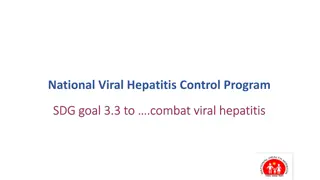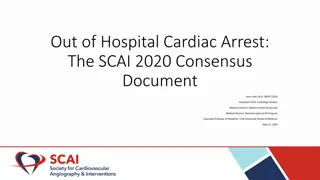Mainstreaming NTD Morbidity Management into Health Insurance Schemes
Explore opportunities for integrating NTD morbidity management into national health insurance schemes for improved universal health coverage. Discuss sustainable practices, data collection, and service capacity building.
1 views • 11 slides
Analysis of Listeriosis Rates in Europe 2017-2022
The data presents Listeriosis rates in various European countries from 2017 to 2022, showing cases and rates per country. The information reflects trends in foodborne diseases and highlights differences in morbidity and mortality rates across nations.
0 views • 17 slides
Enhancing Maternal Health: AMPLI-PPHI's Efforts in PPH Prevention and Management
AMPLI-PPHI, led by Michael Muthamia, aims to reduce maternal mortality and morbidity by promoting the adoption of new PPH prevention and treatment drugs. The program focuses on heat-stable carbetocin, tranexamic acid, and misoprostol, aiming to overcome supply-side barriers and shape markets. Target
1 views • 13 slides
Understanding Multidrug Resistance in Bacterial Infections
Multidrug resistance refers to organisms resistant to multiple antibiotics, impacting therapy decisions, increasing morbidity and mortality, and raising healthcare costs. Monitoring resistance profiles can aid in tracking outbreaks, with molecular typing confirming issues. Join the WHONET Webinar Se
0 views • 35 slides
Importance of Single Unit Red Blood Cell Transfusion According to Patient Blood Management Guidelines
Implementing single unit red blood cell transfusion based on patient blood management guidelines is crucial to minimize risks associated with transfusion, such as morbidity, mortality, and length of stay. By following these guidelines, healthcare providers can make informed decisions, reduce unneces
4 views • 18 slides
Guidelines for Treating Chronic Hepatitis C Virus Infection
Clinical guidelines provide evidence-based recommendations for treating and curing chronic HCV infection in adults to improve treatment rates, reduce morbidity and mortality, and support the New York State Hepatitis C Elimination Plan. Recommendations include considerations in HCV treatment initiati
2 views • 28 slides
Nursing Care for Ventilator-Associated Pneumonia (VAP)
Ventilator-Associated Pneumonia (VAP) is defined as lung parenchyma inflammation occurring 48 hours or more after endotracheal intubation and mechanical ventilation initiation. It is a common nosocomial infection in ICU patients, with significant morbidity and mortality rates. Etiology of VAP involv
2 views • 24 slides
Understanding Epidemiological Perspective: Definition, Scope, and Uses
Epidemiology is the scientific study of health-related states and events in populations, focusing on their distribution and determinants. This field helps in analyzing disease frequency, incidence, prevalence, mortality, and morbidity rates. Epidemiologists also examine disease distribution over tim
0 views • 29 slides
Understanding the Hookworm Superfamily Ancylostomatoidea
The superfamily Ancylostomatoidea includes blood-feeding parasites like hookworms, with important species such as Ancylostoma caninum in dogs and Ancylostoma duodenale in humans. These parasites have a complex lifecycle involving transmission through the environment and development within the host.
0 views • 31 slides
Understanding Social Determinants of Health
Chronic conditions like heart disease and cancer have multiple causes, not all biological. Social epidemiology studies the social distribution of health, morbidity, and mortality risk influenced by social status and conditions. Factors such as age, gender, race, socioeconomic status, and social cond
0 views • 32 slides
Developing Cardiovascular Screening Measures for Pregnant and Postpartum Women Project
Cardiovascular disease (CVD) is a leading cause of maternal mortality in the US, with disparities in morbidity. Standardizing evaluation and triage is crucial. Preventability studies show a high potential for identifying at-risk cases. The CVD Toolkit aims to enhance awareness and readiness among he
1 views • 17 slides
Maternal and Child Health Indicators: Objectives and Mortality Rates
Maternal and Child Health (MCH) services aim for the reduction of maternal, perinatal, infant, and childhood mortality and morbidity, promotion of reproductive health, and physical and psychological development of children and adolescents within families. The indicators focus on mortality rates, inc
0 views • 31 slides
Importance of Preconception Care for Maternal and Child Health
Preconception care involves biomedical interventions provided to women and couples before conception to improve their health status and reduce factors contributing to poor maternal and child health outcomes. It aims to enhance maternal and child health in both the short and long term by addressing p
0 views • 14 slides
Understanding Psychosis in Older Adults
Psychosis in older adults presents unique challenges due to varied etiology, different presentations, and higher associated morbidity. Causes include medical conditions, psychiatric disorders, and certain medications. Delirium, depression, and dementia are common contributors to psychosis in the eld
0 views • 12 slides
POSNOC & ATNEC Trials Update by Amit Goyal: Investigating Axillary Treatment in Breast Cancer
POSNOC (Positive Sentinel Node) and ATNEC trials are investigating the effectiveness of axillary treatment in women with early-stage breast cancer having metastases in one or two sentinel nodes. Led by Chief Investigator Amit Goyal in the UK, this randomized controlled trial compares adjuvant therap
1 views • 21 slides
Understanding Vital Statistics and Health Information Management
Vital records encompass crucial life events such as births, deaths, and marriages, forming the basis of vital statistics. These statistics serve to quantify and analyze various aspects of health, including mortality, morbidity, and population dynamics. Health Information Systems play a pivotal role
1 views • 30 slides
Division of Cardiology Morbidity & Mortality Conference Summary
The Division of Cardiology's Morbidity & Mortality Conference discussed a case involving a patient with an LVAD presenting with "low flows," a delayed diagnosis of GIB, and delayed transfusion. The level ofCONTENT for the corresponding Medical Record Number (MRN) includes a timeline of events that l
0 views • 14 slides
Understanding Bipolar Disorder in Older Adults
Bipolar disorder in older adults can have a later onset, often after the age of 50, with episodes of mania and depression. Recognizing symptoms like excessive energy, inability to sleep, and cognitive impairment is crucial. Late-onset bipolar disorder differs from early-onset in familial illness rat
1 views • 12 slides
Clinical Practice Guidelines for Rhabdomyolysis: Management and Recommendations
Rhabdomyolysis is a condition with a significant impact on kidney function, requiring prompt clinical management to prevent morbidity and mortality. This article discusses the prevalence, patient population criteria, admission criteria, treatment options, and potential complications associated with
1 views • 13 slides
Understanding ICD-11 and Morbidity Coding Principles
ICD-11 is a classification system that groups entities based on statistical relevance and specificity of codes. Entities without specific codes are assigned to residual codes (Y for specified, Z for unspecified) based on hierarchy. Examples illustrate the differentiation between specified and unspec
0 views • 15 slides
Understanding Breech Presentation in Pregnancy
Breech presentation in pregnancy occurs when the baby is positioned buttocks or feet first instead of head first, which can complicate delivery and increase risks of perinatal mortality and morbidity. This article covers the types of breech presentation, symptoms, causes, diagnosis, management, and
9 views • 21 slides
National Viral Hepatitis Control Program - Achieving Universal Health Coverage and Elimination Goals
The National Viral Hepatitis Control Program in India is working towards combating viral hepatitis and achieving SDG goal 3.3 through a comprehensive approach that includes awareness generation, prevention, management, and financing under the NHM. The aim is to eliminate hepatitis C by 2030, reduce
0 views • 19 slides
Understanding Trends in Mortality and Morbidity in India
The paper discusses the perplexing rise in morbidity alongside improvements in various health and socioeconomic indicators in India. It explores the complex relationship between mortality and morbidity and the need for a combined macro and micro research approach to gain fresh insights into the issu
0 views • 41 slides
Overview of Mycoplasma Species and Contagious Bovine Pleuropneumonia
The Mycoplasma genus, including Acholeplasma and Ureaplasma, consists of Gram-negative bacteria with unique characteristics such as lacking cell walls. Mycoplasma species are responsible for causing various diseases in livestock, including bovine and caprine pleuropneumonia. Contagious Bovine Pleuro
0 views • 13 slides
Clinical and Laboratory Features of Radical Total Gastrectomy: Early Outcomes
Assessing the clinical and laboratory features, as well as the early outcomes following radical total gastrectomy is crucial in the management of gastric cancer. This study conducted at Hanoi Oncology Hospital retrospectively analyzed 43 patients who underwent this procedure. The overview includes d
0 views • 27 slides
Management Recommendations for Out-of-Hospital Cardiac Arrest Patients
Out-of-hospital cardiac arrest (OHCA) is a critical public health issue with high mortality rates. This consensus document by Dr. Amir Lotfi provides evidence-based recommendations for managing OHCA patients, particularly focusing on those with shockable rhythms and return of spontaneous circulation
0 views • 18 slides
Comprehensive Management of Head Injury: Overview and Key Strategies
Head injuries pose a significant threat to morbidity and mortality, with causes ranging from motor accidents to child abuse and falls. Understanding the epidemiology and pathophysiology of head injuries is crucial for effective management. Primary and secondary brain injuries necessitate immediate c
0 views • 42 slides
Comprehensive Overview of Medical Risks and Strategies in ECT
In this detailed presentation, various aspects of medical risks associated with Electroconvulsive Therapy (ECT) are discussed, along with strategies to mitigate complications. Topics covered include the physiological effects of ECT on the cardiovascular, neurological, and endocrine systems, as well
0 views • 27 slides
Achievements and Progress of the Global Programme to Eliminate Lymphatic Filariasis
The Global Programme to Eliminate Lymphatic Filariasis (GPELF) aims to eradicate LF as a public health problem through mass drug administration and morbidity management. Significant achievements include treating billions of individuals, reducing infection rates in many countries, and validating LF e
0 views • 13 slides
Understanding Organic Brain Syndrome & Delirium
Overview of organic brain syndrome and delirium, including definitions, clinical features, and management. Delirium, a common psychiatric syndrome, affects consciousness, cognition, and perception, leading to increased morbidity and mortality. Recognize core symptoms, such as disturbances in conscio
0 views • 37 slides
Nursing Management of High-Risk Newborns: Post-Mature Infant Focus
High-risk newborns, including post-mature infants, require specialized care due to their increased chances of morbidity. Identification, goals, assessment, nursing principles, and management strategies are crucial in providing effective care for these vulnerable neonates. Predisposing factors, clini
0 views • 17 slides
Addressing Maternal Morbidity and Mortality in KwaZulu-Natal, South Africa: A Multi-Staged Approach
This study focuses on reducing maternal morbidity and mortality rates in KwaZulu-Natal, South Africa, which remain unacceptably high. The research by Firoza Haffejee and Nokuthula Sibiya highlights the need for a comprehensive, multi-disciplinary healthcare strategy to tackle the various factors con
0 views • 31 slides
Understanding Preterm Birth: Causes, Diagnosis, and Management
Preterm birth, occurring before 37 weeks of gestation, is a significant concern in obstetrics due to its association with perinatal mortality and morbidity. This article delves into the definition, incidence, etiology, risk factors, diagnosis, and management of preterm labor, providing insights on a
0 views • 8 slides
Understanding Viral Infections of the Respiratory System
Respiratory viral infections are common and primarily caused by viruses, leading to morbidity and time off work. They can range from mild upper respiratory tract infections to severe lower respiratory tract infections like pneumonia. Various viruses like influenza, parainfluenza, respiratory syncyti
0 views • 23 slides
Understanding Pasteurellosis (Fowl Cholera) in Poultry: Causes, Symptoms, and Management
Pasteurellosis, also known as Fowl Cholera, is an acute septicemic disease affecting domestic fowl and wild birds caused by Pasteurella multocida. This disease is characterized by high morbidity and mortality rates, primarily impacting chickens, turkeys, and ducks. The disease spreads through health
0 views • 10 slides
Understanding Multi-morbidity and Deprivation in UK General Practice
Exploring the association between multi-morbidity, deprivation, and life expectancy in the context of UK general practice. The research aims to quantify socio-economic inequalities in chronic disease onset and life expectancy, particularly among older populations with multi-morbidity. Methods includ
0 views • 27 slides
Incidence and Antibiotic Susceptibility of Staphylococcus aureus on Door Handles in Ahmadu Bello University
Environmental microorganisms, like Staphylococcus aureus, play a significant role in morbidity and mortality. This study explores the incidence and antibiotic susceptibility profile of Staphylococcus aureus isolated from door handles in Ahmadu Bello University, Zaria, Nigeria. The research aims to a
0 views • 22 slides
Understanding Acute Diarrheal Illness and Gastrointestinal Infections
Acute diarrheal illness is a common issue globally, leading to significant morbidity and mortality. This lecture covers the types of acute diarrhea, host defenses, pathogens like E. coli, Campylobacter, and Yersinia, and their management. It also discusses microbiological diagnosis methods, food poi
0 views • 30 slides
Understanding Diabetic Foot Infections and Associated Risks
Diabetic patients are prone to infections, significantly impacting morbidity and mortality rates. Increased infection risk is due to both host-related and organism-related factors. Common infections in diabetic patients include skin and soft tissue infections, diabetic foot infections, respiratory t
0 views • 14 slides
Importance of WASH in Healthcare Facilities: An Overview
WASH in healthcare facilities is crucial for providing a safe and hygienic environment. It includes water, sanitation, hand hygiene, healthcare waste management, and environmental cleaning. Basic WASH activities in facilities are essential for patient care and preventing infections. The historical s
0 views • 19 slides







































